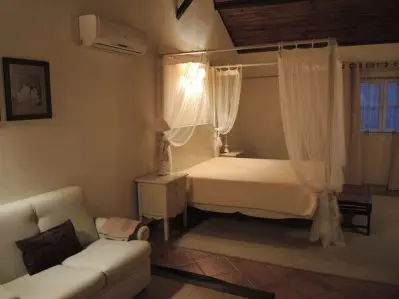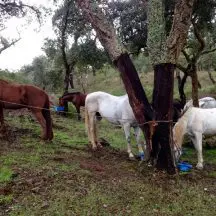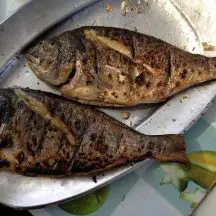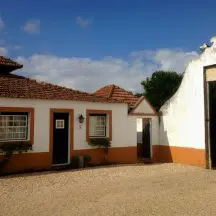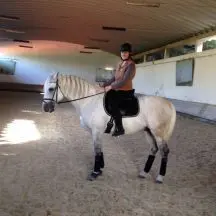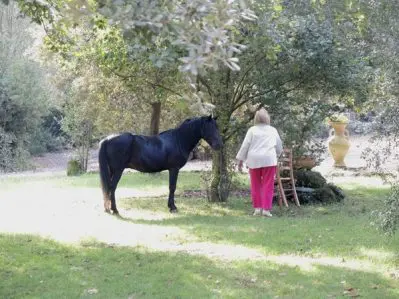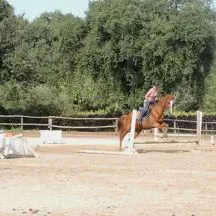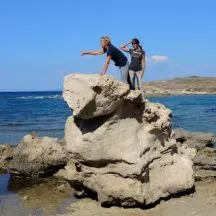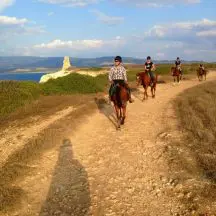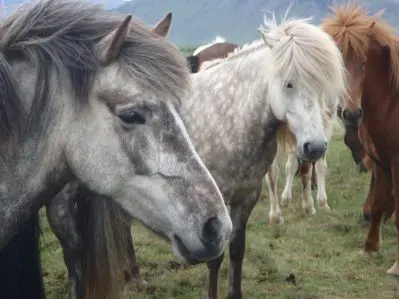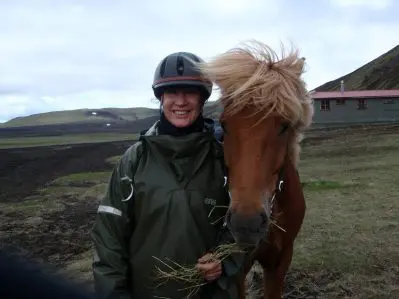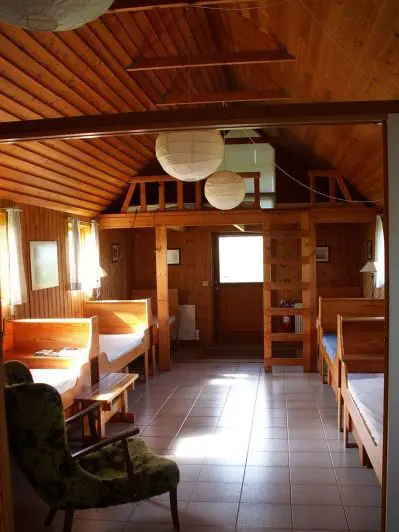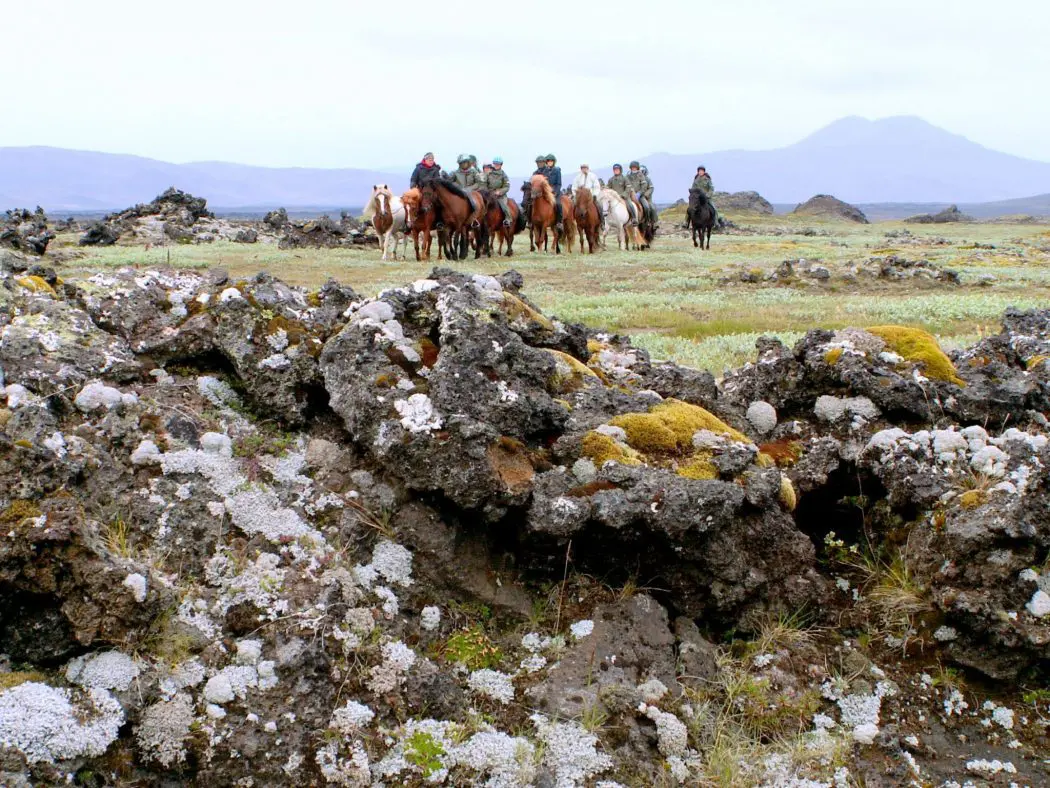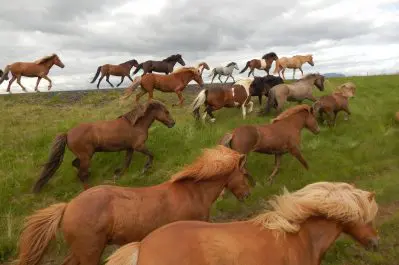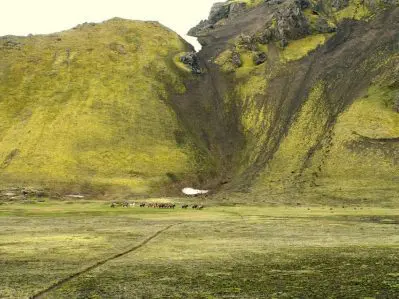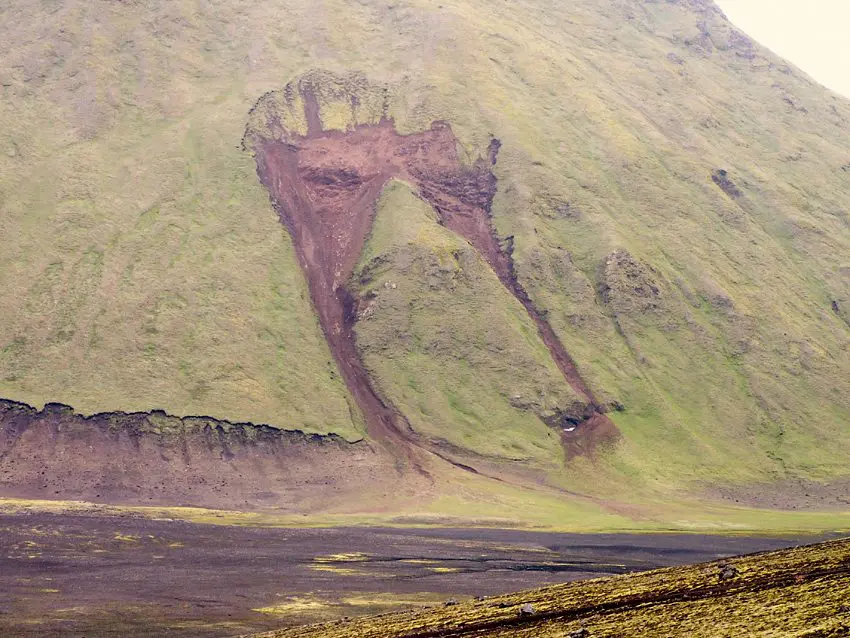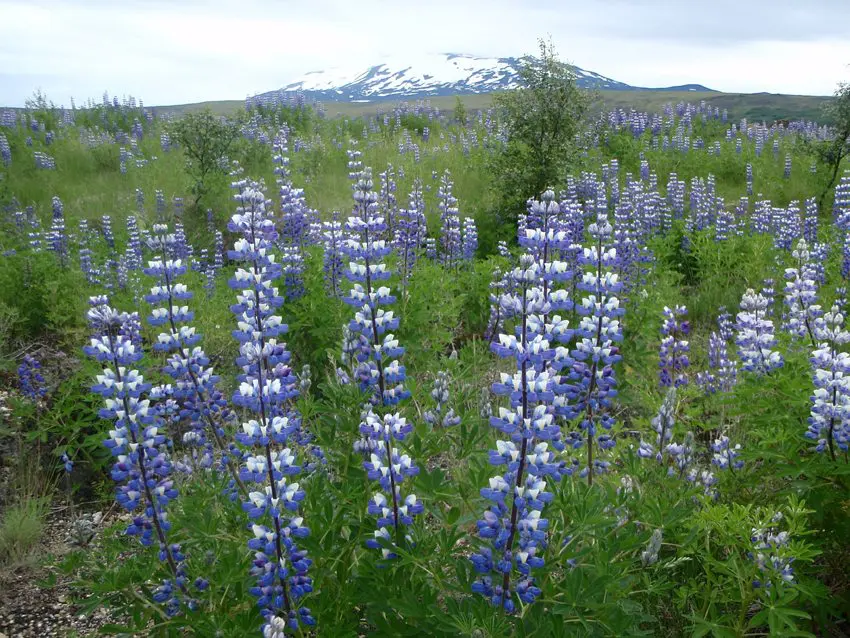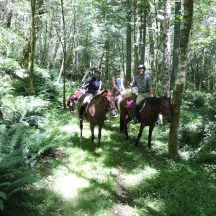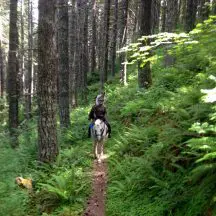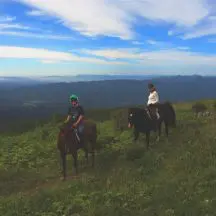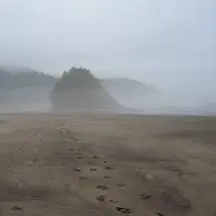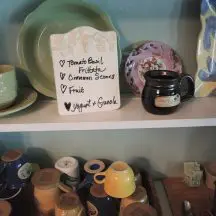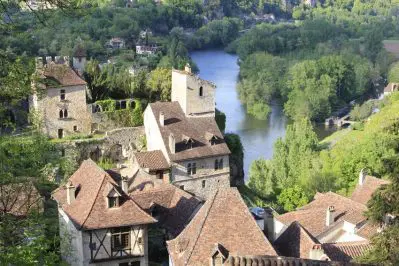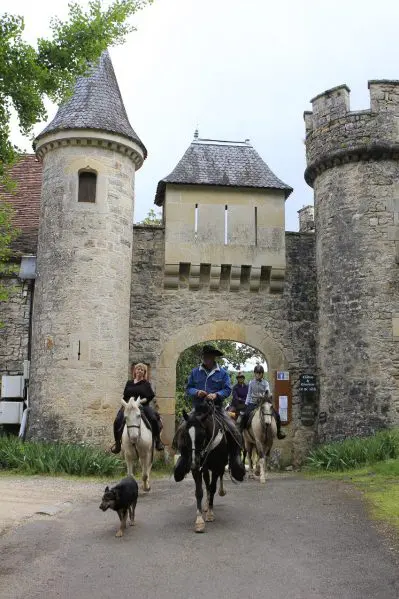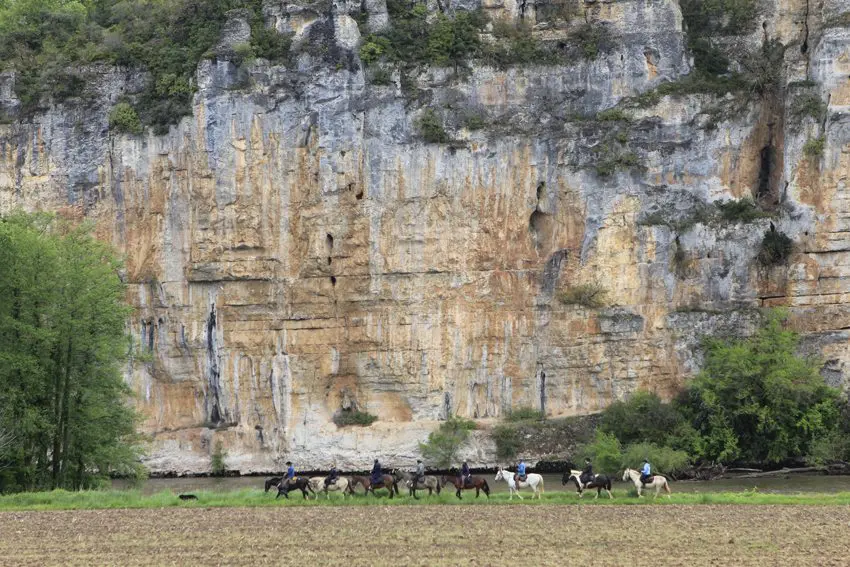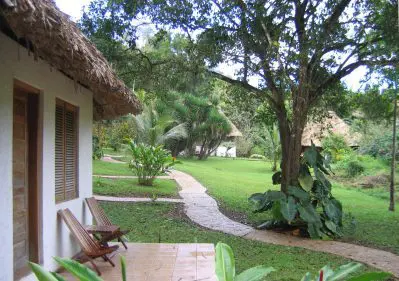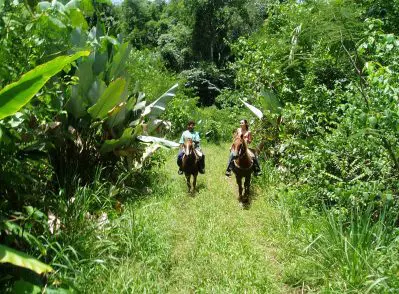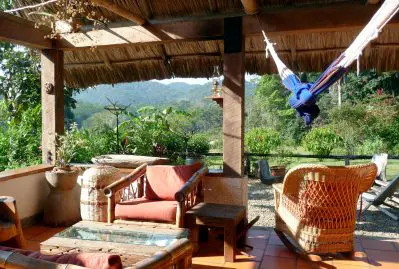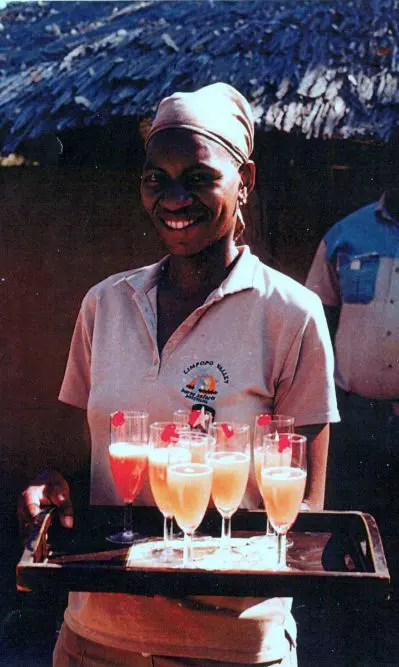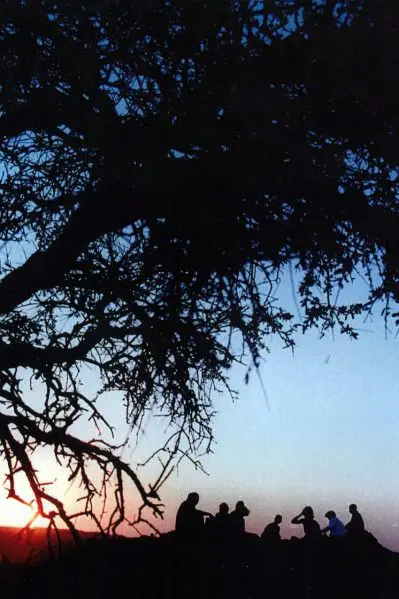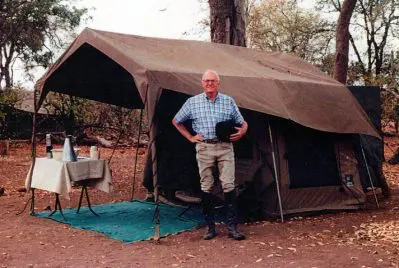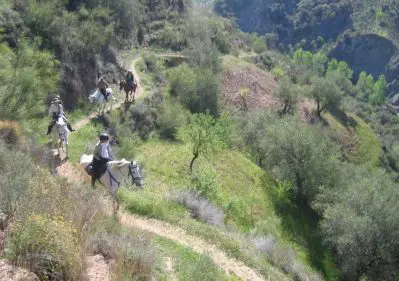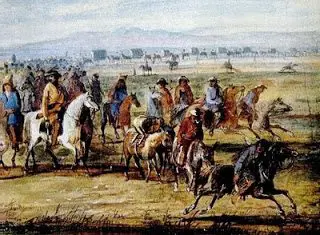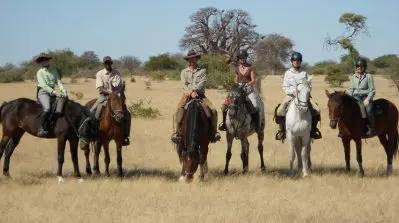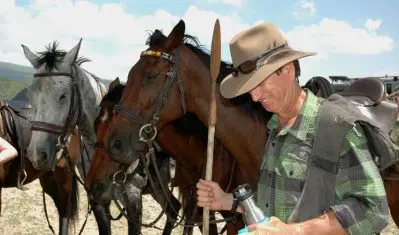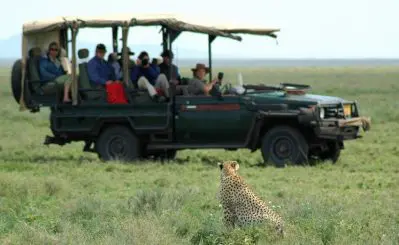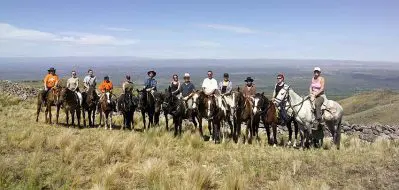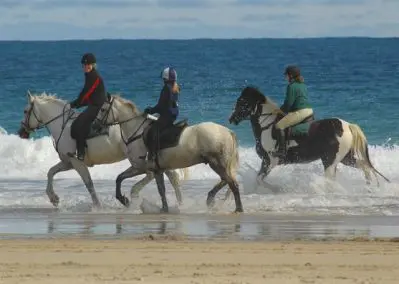Please enjoy the below photo slideshow created by Mel Fox following her Glacier Estancia ride in Chile.
Bayard Fox, founder of Equitours and Bitterroot Ranch, was featured in Hurlingham Polo
From my ranch in Wyoming I can see a range of mountains, towering more than 13,000 feet into the sky. No other human dwelling in sight. I live in a remote valley next to the cast Yellowstone Ecosystem…
Read the full story here: Feature on Bayard Fox in Hurlingham Polo
Horseback Riding History Has Multiple Aspects
There are countless facets to the complex relationship between men and horses which has been so crucial to both species. We summarize some of the most important below with links to more detailed discussions of the particular subject elsewhere on our websites. How can we know who we are or find a wise direction for the future without knowledge of what formed us? Horses originated in America and many millennia ago some made the journey across the Bering Straits to Asia and Europe where they thrived. Men began to hunt them and found them an excellent food source which they still are today in many countries. The cave drawings dating back over 20,000 years in places like Alta Mira attest to this though probably they were not used for riding until much later when the horsemen of the Steppes discovered their revolutionary advantages for this purpose.
An outstanding example of how the use of horses could revolutionize a society is the sudden acquisition of the horse by the Plains Indians after the Santa Fe Rebellion of 1680. It is ironic to consider that Native Americans are now thought to have hunted horses in North America to extinction about 10,000 years ago. It is fascinating to speculate what course world history might have taken if Native Americans had discovered the real potential of horses and they had not crossed the Bering Straits. Without the horse to help free us from the struggle to feed ourselves by doing the heavy farm work like plowing and harvesting, we would have had much less time to devote to art and science. European and Asian societies could never have developed as fast as they did and the ultimate clash of continents might have had an entirely different result.

Mounted Indians closely pursuing a buffalo herd on horseback.
Travel on horseback made possible the cohesion of great empires like Persia which stretched from Turkey and Egypt to the borders of India until its destruction by Alexander the Great. The Persian mounted couriers routinely made the 2,000 mile journey from Sardis to Susa in 7 days and their messenger system had many offshoots to the farthest corners of their empire.
Cavalry were very often a determining factor in winning the strategic battles which changed the course of history. The incredibly swift spread of Islam and Arab domination across large parts of Europe, Africa and Asia was made possible by mounted horsemen riding superb Arabians. Their advance was only barely turned back by the heavy cavalry of the Franks at the battle of Poitiers in central France where the then recent innovation of the stirrup may have played a deciding role. That battle and those that followed drove the Moslems out of France and may be the reason why most of us go to church now instead of the mosque. It was the intervention of the Polish Cavalry under Sobieski which saved Vienna during the siege of 1683 at the last moment and deprived the Turks of a strategic foothold deep in central Europe.
Horses have helped mankind in other ways besides warfare, travel and transport. They have enormously facilitated hunting in many parts of the world as in the case of the Plains Indians and the buffalo. Another very useful task for which horses are exceptionally well adapted and which they often enjoy is working livestock. They are almost indispensable for cattle drives even today. While it cannot be termed riding, horses revolutionized agriculture by plowing the fields, harvesting the crops etc. making it possible for one man to do the work of ten.
Did you ever stop to think how many expressions we still use related to horses in our everyday speech? We hear things like “champing at the bit”, “dark horse”, “Trojan horse”, “eats like a horse” or “horse sense” and dozens of others very frequently.
Many equine sports practiced today derive from necessary tasks performed by riders. A prime example is dressage which originated by performing battle maneuvers like the capriole which must have been devastating to surrounding foot soldiers. Rodeos, fox hunting, reining, team penning, tent pegging, bullfighting, buzkashi, jumping and polo are a few. The outstanding example is horse racing, “the sport of kings”, watched by millions where the big money is today.
The often tragic history of the wild mustangs which are descendants of the horses escaped from the Spaniards is another interesting chapter. In the late 17th and 18th centuries some of these fine horses coming from the best Spanish blood lines escaped to the wild and multiplied on the Great Plains until they numbered several million. Predators could rarely kill them because they were fast, had keen hearing, an excellent sense of smell and a very powerful kick as well as strong jaws. According to J. Frank Dobie in his wonderful book, “Mustangs” and others who should know, some of these horses even sought out predators like mountain lions and wolves to kill them. There are also feral horses in Australia known as brumbies and made famous in that wonderful Banjo Patterson poem “The man from Snowy River,” also made into a movie.
Individual states like Wyoming, Arizona, Utah and Texas have their own unique histories. Each of these states and many others as well owed their settlement and early development to horseback riding. The cattle ranches, which were long vitally important to their economy, would not have been possible without the use of horses and the wild mustangs provided an abundant supply of mounts. At the same time the superb cavalry of tribes like the Comanche and the Sioux considerably delayed white settlement.
While horses are no longer indispensable to the daily lives of most of us as they were 100 years ago, they remain very popular in our society as a sport and a diversion. There is no denying the tremendous aesthetic appeal of these magnificent equine athletes in motion which have captivated mankind for millennia. Many of us find them responsive pets who form a close bond with their riders and share our pleasure in a fast canter or an interesting trail ride. Cow horses seem to enjoy working cattle as much as we do if not more. We are also rediscovering the great pleasure of traveling on horseback simply for pleasure and education. There are abundant and varied possibilities.
Other related articles:
Sampling Lusitano horseback riding
My week in experiencing riding vacations in Portugal was split between our host south of Lisbon and the other farther north. It began at the international airport in Lisbon as our group all found each other at the meeting point based on examining one another’s riding shoes or jackets, or perhaps recognizing the general air of a person who rides horses. It was an eclectic group, with participants from Belgium, Norway, England, Germany and Denmark. English was the common language of all and we were all happy to talk about our horses at home or other trips we had taken before. The guide, Miguel, met us and greeted those guests who were returning (some for the 8th time!) with great enthusiasm, and quickly learned all our names and gave us a useful packet with a map of our route, schedule, and contact information. The three accommodations used by the Dolphin Trail, our itinerary, form a triangle, and the riding is from one to the other, with a day of riding in each area, so that you are moving basically every two nights. The Alentejo Coast uses some of the same accommodations, and the route is linear, from either north to south or south to north depending on the date.
It took about an hour and half to drive from the airport to our first destination, which was immediately welcoming with its comfort and luxury. The accommodations throughout were wonderful in that they made guests feel at home but also pampered.
Dinner was served each night at our hotel, although later in the week a there was also a dinner at a local restaurant, and a generous breakfast buffet greeted us each morning. During our first dinner Miguel ate with us and asked us all about our riding experience and type of horse we liked, storing that information away to help with the horse designation the next morning.
Most horses are Lusitano crosses, with some pure Lusitanos as well. I had a beautiful chestnut horse aptly named “Santo,” as he was perfect for me each day that I rode him. What was lovely about riding him was that he was happy to go at a gentle lope near the end of line, and also happy to stay up front and lead the pack during our long canters. There were horses to suit all riders, including a woman who had never ridden outside of the arena before who rode a gentle older horse who knew the ropes well and followed the group faithfully. It was a fully booked group of 12 riders, and the horses behaved admirably as a whole. The saddles used were all McClellan, with comfortable layers of foam and sheepskin, and the bridles were a French style snaffle. At some points of the trip we would ride briefly along paved roads through town, and Miguel would ask us to ride in pairs along the side of the road and stay together as a group and both horses and cars behaved well!
- Santo
- Horses enjoying their lunch as we enjoy ours
- Grilled fish for lunch
- Enjoying the ride even in the rain!
After a morning of riding through cork or eucalyptus forests we would reach our picnic destination, where the backup guide had prepared a table and chairs for us, and a line to which to tie the horses. Each guest untacked her horse and then we all fed them grain in a single synchronized movement. We would enjoy salad and homemade bread with red wine until the day’s meat or fish was finished grilling and then add it to our plates. I unfortunately do not eat sea food and so missed out on the spectacular fish one day that others claimed was the best they’d ever eaten.

The horses at home
After a leisurely lunch we would groom and tack our horses and be off for the afternoon ride to our night’s accommodations. The horses either stayed on the grounds, or at their home stables a short distance away. Here there are rows of Lusitanos in narrow stalls, often eager for their meals while we were there, but usually spending their days in the open fields nearby.
Although it had been rainy our first few days, it did not dampen anyone’s enjoyment or enthusiasm. The weather cleared to enjoy riding under bright blue skies and for the rest of the group to continue on with the dolphin excursion and the beach. I parted ways and headed back to Lisbon and to my next destination.
Based out of Azambuja, about forty-five minutes north of Lisbon, is the stud farm that serves as the starting point for the Traditions and Culture itineraries. Although there were no trips scheduled for the time I was visiting, I got to see many of the trips’ destinations and spend some time at the farm.

Lusitano faces
The purebred Lusitanos are bred and trained for competitive dressage and I enjoyed wandering down the stall aisles visiting the beautiful stallions and watching the trainers at their impressive work. I even got to ride one of these stallions as I sampled a dressage lesson. The horses used for the treks are all pure Lusitano mares, most bred at the farm with basic dressage skills. I rode a lovely mare called “Divulgadora” who was very easy to ride and responsive to the aids. On the trail I was especially impressed with the tack, which was all of excellent quality. I had never seen the type of saddle I rode in, in a dressage style, but with a wonderful padded seat designed for the trail which was very comfortable. Divulgadora confidently carried me through the vineyard and forest that surrounds the farm, with beautiful views of the countryside. Edgar, my guide, greeted a man in the vineyard, explaining to me that it was his cousin; Edgar had grown up there and had ridden through the land since he was young. These sorts of authentic connections to the local culture are often purposeful and unique part of these trips.
Although it was still a bit cloudy one day of touring, my host, Tiago, said that the next destination would be impressive. “I know it’s dangerous to guarantee anything 100%,” he said, “but I am that confident in this spot. You will be wow’ed.” With an introduction like that, I couldn’t wait to see where we were headed! The spot was Quinta da Boavista, one of the many quintas the itineraries travel to for lunch, dinner, or overnight. The name was perfectly suited, as the view over the Tagus River was spectacular. “Wow,” I murmured, totally proving Tiago’s assumptions correct. This was a place that would completely be enjoyed by riders on the Traditions and Culture itinerary as they stopped for lunch. The owner of this estate also is carriage driver, and at the end of the meal often drove with the riders as they left, offering a tutorial to those who were interested.
- The “wow factor” view
- A Lusitano bred by the host in a traditional Portuguese bullfight
- One of the charming quintas
This is the strength of these itineraries, the connection to the local estates and culture that it offers. Tiago has developed the itineraries keeping in mind the clear goal of eliciting the “wow” response at least once per day, be it by the beauty of the surrounding nature or the interest of a local cultural spot. Another highlight was a nearby restaurant in the town of Santarém. Called “O Forcada,” the décor is dedicated to bullfighting (a “forcado” is a group of eight men who challenge the bull directly with no weapon or defense). While Quinta da Boavista had made me feel like I was part of the nobility, O Forcada made me feel like a part of a local family. The host greeted us warmly and the restaurant’s history and authentic commitment to and love of the traditional bullfighting culture was evident. (As a note, the Portuguese style of bullfighting differs from the Spanish style in that the bull is not killed. As a former spectator of bullfighting in Madrid, I appreciate the distinction!)
The accommodations at the quintas, like at the restaurant O Forcada, all offer wonderful hospitality as the hosts seem genuinely pleased to open their homes to you. As they are authentic farm houses, the amenities are not all necessarily luxurious, but comfortable and perfectly adequate. Another special location was the Quinta da Lapa, which is an operating vineyard with lovely rooms and views. Close to the nature reserve of Torre Bela, riders on the Secrets of Ribatejo itinerary will stay here to ride through this area protected for deer, fox, boar and birds.
My week in Portugal was able to offer a wonderful introduction to the riding here, both along the coast’s southern sandy tracks and through the northern quinta farmland. The commitment of both hosts to provide a high quality experience and their fine Lusitano horses add to my confidence that this is a promising destination that will many riders will enjoy.
Riding and Exploring during this unique riding vacation in Italy
I was struck by the charm of the inn the moment I stepped from the car near Abbessanta, Sardinia. Granted, my lack of Italian might have made it easier for the “Scuderia” sign at the stable to impress me with its exotic nature, but there was an authentic feeling of this place’s heritage. This was combined immediately with comfort and hospitality as I was greeted by the manager, Betty, and promptly offered a welcome drink. After dropping off my bags in my garden bungalow I opted to join dinner that was just about to start, rather than to take up the offer to settle into my room, as I knew jet lag was lapping at the edges of my consciousness. Although Sardinia had not been particularly difficult to reach, being only a short plane ride from the main Fiumincino airport in Rome, it had been my fourth plane coming from Equitours’ headquarters in the very remote Dubois, WY, so I knew exhaustion was likely to claim me if I paused too long.
Luckily, the food and company at dinner were restorative, and although I had lost track of all the meals I had eaten that long day, I fully enjoyed each bite of the generous four courses, including melon and prosciutto, minestrone, sausage, and red wine from the property’s own grapes. Betty, a perceptive woman who seems to be able to foresee guests’ needs and desires before they do themselves, is Dutch, and fluent not only in English and Italian, but also many other languages, allowing her to communicate well with all guests for this riding vacation in Italy, as they originate predominantly from Germany, Switzerland, Holland and England. She served as translator as Daniele, the owner, discussed with me the riding programs that they offer, and his family’s long history on the property. The horses came before the hotel, and the horses were part of the farm’s existence from the beginning, about five generations earlier. Eventually they became its focus when the family began concentrating its efforts on breeding, training and competing Anglo-Arabians. The owner himself was a serious jumping competitor, and has recently turned his focus to endurance racing, for which his horses are particularly well-adapted.
These horses used for competition are also used for the guest rides, and so have very good condition and training. He told me how he developed all of the trails from the stables, finding the best route to offer to guests, and has since turned over leading the majority of the rides to a few long-term guides. As I was arriving before the Monti & Mare itinerary was set to begin, we made a plan for my upcoming days, including a lesson and a trail ride around the property.
I slept well in my peaceful and comfortable room, and awoke to the sound of hooves as a rider cooled out her horse after an early morning lesson. I selected my breakfast from the full buffet, including the typical European fare of meats and cheeses and also offering eggs made to order. In the lovely weather of early October, other guests were scattered at tables on the terraces and lawn. I had already heard a lot about the wild Sardinian horse that had been adopted and domesticated, and saw a full performance of his charm while enjoying breakfast. All horses graze on the lawn and grounds during the day, and when he was released he went directly to the lawn’s apple tree and stomped the ground impatiently, tossing his head and throwing his pretty black mane in to the air. He has worked out this routine, because he knows that if he insists Betty will climb a chair and shake down apples for his own personal enjoyment. The wild Sardinian horse is small but strong, and its band is the largest in Europe. While certainly enjoying the comfortable life here, this horse was not typically used for guests, but only for a few talented young riders.
And riders there are! With two instructors the arena was doing brisk business, mostly beginner riders who were well-taken care of, and a few jumping lessons.
Stable staff or riders were often seen crossing the lawn, bucket of grain and halter in hand to catch the next mount. That morning I helped catch and tack my horse, an Anglo-Arabian called Nepita, who couldn’t be bothered to put too much effort into the arena riding, but was willing to go on the trail! Our afternoon trail ride started benignly enough, but the weather soon turned inclement, and we were treated to a two hour ride in a down pouring rain and thunder. “This never happens!” Illa, my guide, told me. “It hasn’t rained in two months!” It was apparently just my lucky day. The ride was still enjoyable, despite the weather’s best attempts to dampen our enthusiasm, as we made our way down ancient shepherds’ paths and past their pastures of sheep. The narrow dirt track provided the perfect opportunity for a long, fast canter, and the rain and puddles added to the drama and fun of it all. Illa told me that I was smiling ear to ear while following her at a brisk canter, and I don’t doubt at all that my enjoyment was that obvious.
- A morning jumping lesson
- My bungalow and a grazing neighbor
When it wasn’t raining and I wasn’t riding, I had time to enjoy the sunshine beside the pool or outside my room. Numerous comfortable chairs are well positioned to enjoy both sun and shade, and the pool is pretty and inviting. I paused in my reading to watch a few horses wandering around the pool area, serenely eating and shaking away the flies.
The next day was the start of the Monti & Mare itinerary, and I met the other participants, two women from the Netherlands who compete in dressage at home, and a couple from England who had been to the inn many times before. They had actually done this itinerary earlier the same year, and so we were doing it backwards to provide some variety for them, and starting at the coast rather than at the main stables. Before riding, we stopped by an endurance competition that was taking place near the paddocks on the coast, and in which Daniele and a few of his horses were participating. Daniele was riding a young horse to get him qualified for the shorter distances, and a young rider was racing one of the most experienced horses, and a popular guest horse, so that the rider could become qualified. Daniele’s Anglo-Arabians were in good company of other fit Arabian horses, and we watched with interest the process of cooling, watering, and vet checking the horses as they came into the check point. Daniele and his horses all competed admirably, and then it was our turn to be the jockeys.
First though, we had to eat. This is Italy after all. We drove to the coast line and Illa led us to a hidden stony beach where she spread out a lavish picnic of bread, meat, cheese, tomatoes from the garden, and white wine. The beach was beautiful and we enjoyed a leisurely meal while contemplating the vast blue-green of the ocean before us.
- “Bob,” the experienced endurance and competition horse amid the hustle of the vet check
- Exploring the beach
- Riding along the coast with the Spanish tower in the background
- Back home
Then we packed up and headed out to the paddocks, where we Illa pointed out our mounts to catch, groom, and tack. I used Daniele’s new saddle that he had just raced in, but the other tack was well-worn. The island lifestyle often calls for the inhabitants to use what is available to them, and all fitted the horses well and safely. After Illa had made sure we were all tacked and mounted appropriately, we headed out for a few hours’ ride. We followed the sandy tracks with the tall bamboo on either side, went through fields and past brackish lagoons, before coming upon the beach itself. The coastline reminded me of Ireland with its cliffs and crags, as well as the pastures of sheep beside. We passed a Spanish tower built in the 1500s when the island was under the control of that country to ward off Moorish attacks, and enjoyed fast canters. My horse seemed rather put out to not be in the lead, and keen to go for as long as the day’s trek called for, but the other horses seemed to content at an easy canter behind us. Our path took us on the sandy beach only briefly, and the horses were happy to walk in the waves’ surf. The other participants teasingly reminded me that I would be missing the next day, when they would spend more time on the beach and canter along the shoreline – I would just have to come back!
By the time we returned to the paddocks twilight was falling and the mosquitoes were emerging. The returning guests sagely extracted bug repellent wipes from their packs as we quickly took care of the horses and returned them to their grassy paddocks. We got back to the inn just in time for dinner, after a satisfying day.
I was sorry to leave before dawn the next morning, but was sent off with the same hospitality with which I was welcomed; with a car organized for me and Betty seeing me off with two sandwiches to sustain me through my flights. My glimpse into Sardinia was brief, and enough to leave me impressed with the island’s diversity of landscapes and its unique and fascinating history and culture – full of surprises like the wild horses and the Stone Age nuraghi towers. The fun riding and hospitable hosts made this Sardinian sampling particularly memorable.
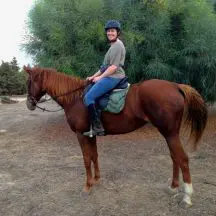
By Megan Barrett, seen here upon her speedy Sardinian Steed
Not for the faint of heart
Icelandic legend spins the tragic, true tale of falsely accused folk hero Fjalla-Eyvindur and his wife Halla. Exiled in the inhospitable highlands with little food and no shelter, their children died in infancy except for one beloved but weak two-year old daughter.
Their hideout discovered, and the need to run upon them, they made a decision. Halla cradled her daughter in her arms and sang her to sleep with the lullaby “Sofðu unga ástin mín” (“Sleep my young darling”) before dropping the slumbering child over a waterfall to a quick and certain death so she and her husband could flee unhindered.
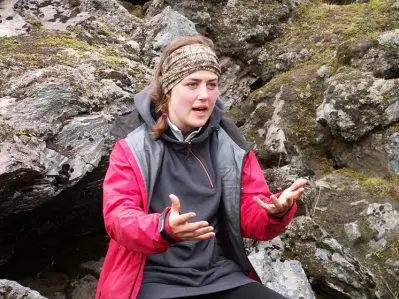
Anita kept us entertained with Icelandic legends as well as informing us about her country’s unique geology.
Our guides Anita and Elva, both young mothers themselves, solemnly sang this lullaby in their heart-wrenchingly clear voices to our group of riders as we rested by a stream in the highlands where the ghost of Fjalla-Eyvindur is rumored to wander. Beside me, the young Danish wrangler Nina fought unsuccessfully to hold back the black tears streaming down her dust-covered face.
“Did you understand all the words?” I whispered once the song had ended. “No,” she choked in reply. ”The music is just so full of sadness.”
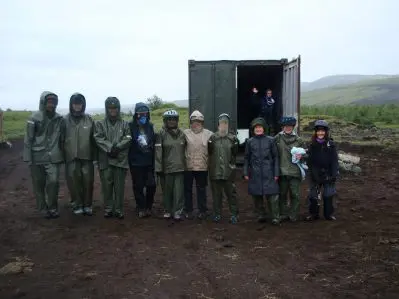
The weather was ever changing. This is our group modeling Icelandic rain gear on the wettest and coldest day.
We were an all-women’s group for the first ride of the Icelandic summer; 16 intrepid riders from America, Australia, Austria, Denmark, Iceland and Switzerland on this dark and blustery June day in the forlorn highlands north and west of the slumbering volcano Hekla. The melancholy tune touched all of us; daughters, wives, mothers, grandmothers… our ages spanning the decades of twenties through sixties, all here to experience riding the iconic Icelandic horses in their ancestral volcanic island home.
Iceland has a population of around 315,000 inhabitants who own over 100,000 of this uniquely pure-bred stock. Brought in longboats to the country by the Vikings from Norway and the British Isles late in the 9th century, they are considered one of the oldest breeds of domestic horses in existence today. Bred more for their temperament and personalities than for color, these friendly, stocky steeds are treated as part of the families they live with. Having evolved in such a harsh environment, they are amazingly surefooted and confident, practically floating over the landscape in their smooth tölt gait. To interact with them is amazing, but to ride them is nothing short of magical.
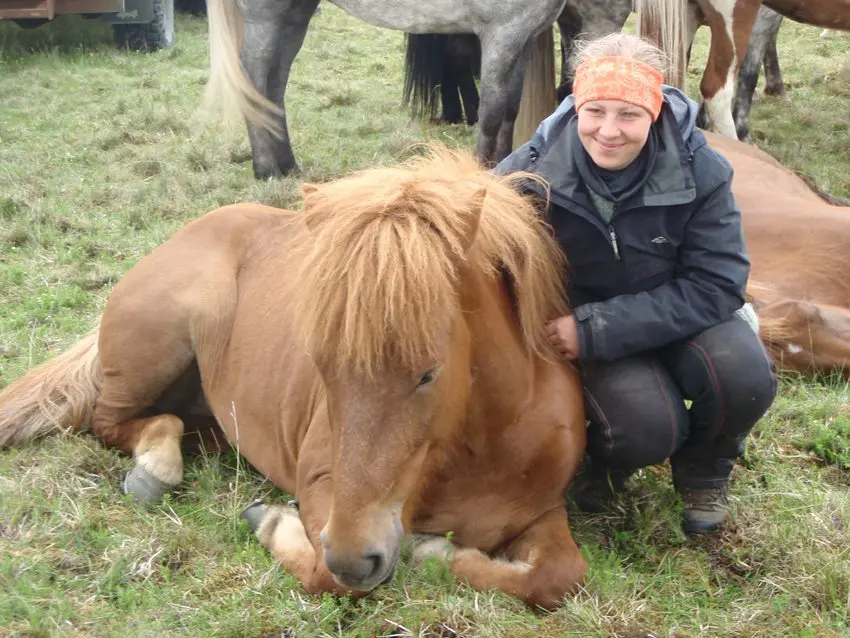
Our Danish Wrangler Nina comforting one of the younger horses who was tired on his first big excursion with the herd and riders.

Our accommodations for the first and last nights were at the outfitters’ farm, which had the typical grass-covered roof.
On arrival night at our hosts’ farmhouse, we were asked to tell a bit about our riding experiences and the type of horse we enjoy riding most. Our guide Anita listened intently to our answers in order to assign each of us two horses to ride in the week ahead, her philosophy being that you must ride a horse three times before the two of you truly connect. The next morning after breakfast we assembled at the nearby corral, greeted by inquisitive eyes shining beneath thick bangs, seemingly as curious about us as we were of them. The barn doors slid open and the wranglers clapped their hands as the herd disappeared into the dark interior. A few minutes passed and the door opened again with a wrangler leading a mount out to each rider in turn. The tongue twisting Icelandic names of the horses were difficult to remember in the beginning. My first steed was Sleipnir, named after the eight-legged horse of the Nordic god Odin. At the age of 17 he was one of the older horses, but was quite forward, attentive and eager to please. Before the farmhouse was out of sight, I had relaxed and given this handsome bay with the thick black mane my full trust.
My other equine companion was a sorrel with a strawberry blonde mane by the name of Plutus, tall for an Icelandic horse at 15 hands. He was only seven years old, but even more mellow than Sleipnir, 10 years his senior. When I remarked on this trait to our host Stefnir, he commented that Plutus “has an old soul”. In addition, however, he also had the flying pace, skeid, which I was able to coax him into on several occasions and together we floated along at our own smooth pace while the more daring riders usually left us, quite literally, “in the dust” as they galloped past.
Those who have never been to Scandinavia or done the Youth Hostel rite of passage in Europe are sometimes taken aback when they see the sleeping arrangements in the cabins and huts along the ride route. Mattress to mattress, bunk-bed style platforms offer sleeping space upon which 16-20 people may roll out their sleeping bags. Of course, in an open room there can be night noises such as people climbing down the ladders in the dark, sleeping bags rustling when someone rolls over, snoring, as well as some folks talking (and even singing!) in their sleep. Anita has a supply of ear plugs available for those who sleep lightly. If you enjoy camping or roughing it, then you’ll do fine. There are flushing toilets at each overnight stop, as well as running water, but showers are only available in 2 of the 4 overnight locations, although there is an opportunity to soak in thermal springs as well as to shower one afternoon in Landmannalaugar. Touring Iceland on horseback is, in many ways, a “change of pace”.
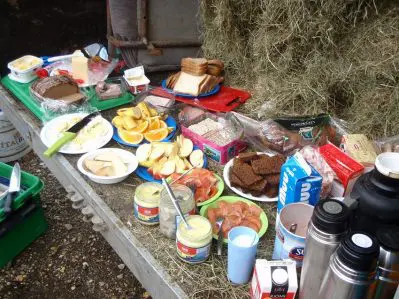
Smoked salmon and lamb, cheese and butter, a variety of breads and even special gluten free and vegetarian dishes were served at every meal.
In regards to food, Anita, Emilia, Elva and Nina were up daily before the guests preparing a buffet style breakfast consisting of muesli, fruit, yogurt, several kinds of homemade bread, jams, honey, and lots of the delicious Icelandic butter and cheese, washed down with ample coffee, tea and hot chocolate. After breakfast everyone would make their own “pocket lunch” for the ride consisting of sandwiches with sliced meats (including smoked lamb), cheese and vegetables, as well as fruit and cookies. Snacks appeared magically while the guests were getting out of their dusty gear at the end of the riding day, followed by freshly prepared warm meals of hearty soup, bread & butter, roasted lamb, fish, vegetables, stews, pasta dishes and desserts. Everyone pitched in with setting the table and washing up, family style.
There is no “cocktail hour” on this ride, no doubt for several reasons. For one, the converted Dodge Ram (lovingly nicknamed “Green Monster”) which transported all our belongings and food for the entire week was stuffed to the ceiling with absolute essentials and no room to transport additional bottles. Anita did surprise us on the trail with a shot of whiskey in our hot chocolate on one particularly cold and wet day, as well as a box of red wine (equivalent to 4 bottles) the night of our farewell dinner. It is possible to purchase beer at the stopover in Landmannalaugar, but other than that, this tour is dry.
Anita had long wanted to offer a designated “all women’s ride”, and it was very interesting to observe the women of diverse ages and cultures interact. The common denominator, as usual on such rides, was horses. We shared our tales of falls and injuries, competitions, places we had ridden in the past and dreams of future rides over supper every evening. We had the great fortune of all being more or less competent equestrians, and no one came off their horse during the week. I’ll certainly give my kudos to Sleipnir and Plutus, who never stumbled or shied while moving along confidently with the herd of free-running horses that accompanied us.
Now that was an experience! Riding with a herd of free horses mixed amongst the riders, tölting along with luxurious manes and tails flying, accompanied by the four-beat sound of hooves pounding the volcanic soil, clipping over paved roads, splashing through rivers, striking rocks. Since the Icelandic horses are raised in this rugged environment, they know how best to navigate it. This particular horse herd is very familiar with the ride route and knows where to stop, wait, slow down, or go full throttle. After a very short time, I was able to totally relax and be one with my horse in this colorful tölting procession. It’s a remarkable experience for sure.
We left the herd at a base camp on the days we ventured into the remote areas of the highlands. Climbing high to the rims of black and red craters filled with turquoise lakes, galloping over the black crater floors of extinct volcanoes, leaving temporary tracks of our existence in the wind-swept surface, riding quietly as tiny specks against the massive mountains around us…Iceland can make a person feel very small but very strong at the same time.
The Icelandic women are remarkable, physically and in spirit. They can shoe horses, change flat tires, bake and cook and explore mountaintops, live at the foot of active volcanoes, sing folk songs, raise children and slaughter lambs, all the while being warm and gracious to strangers. Their strength was evident to us during our summer ride. I can only imagine the trials of surviving winter on the island, which brings us back to the chillingly beautiful song sung to our group by Anita and Elva as we entered the desolate and mysterious highland area where there is no food, shelter or lodging and where the basalt formations and mountain features take on the shape of trolls and monsters in the mists.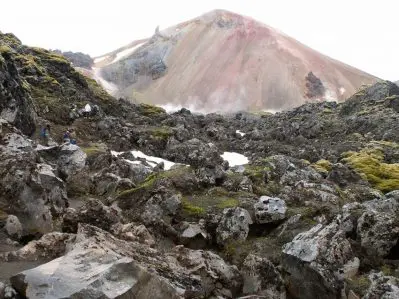
To enjoy a ride over this sometimes verdant but more often stark topography, riders must have the willingness to give up their creature comforts for a week in return for an in depth experience in one of the most unusual places on earth as seen from the strong backs of the dependable Icelandic horses. In my case, the reward was the ride of a lifetime.
Ride review by Trudy Trevarthen
Oregon’s Forests, Beaches and Vineyards
The hosts and guides of the Willamette Coast ride come from a strong riding and outfitting background. The husband and wife team of Justin and Lindley Leahy oversee all aspects of this adventurous trip, from planning the route and choosing the horses, to making sure you have fresh vegetables from their garden for your lunches. Justin comes from an outfitting family in Ireland and grew up riding and training Connemara horses and riding on his father’s Connemara Trail. He and Lindley ran a successful equestrian riding and trekking center in Illinois and after much research chose their Oregon location as the best spot to provide a progressive riding vacation for strong and adventurous riders. The reasoning behind their decision is certainly sound; from their base in the Willamette Valley they can offer riding through the vast Siuslaw National Forest, with a rainforest climate which brings to mind the lands of Tolkien, to the coast, dramatic in its mists and rock formations, and back to the valley itself and its profusion of vineyards and wineries.
- Riding through the Siuslaw National Forest
- Mt Hebo Pioneer Indian trail
This is indeed the route the Willamette Coast ride takes. The first few days the horses are ridden point to point across the Coast Range through the lush greenery of the forest. The trails vary from gravel mountain roads which allow you to move out in brisk trots and canters, to thick circuitous trails following the paths of elk. The horses are impressively sure-footed and responsive, willing and able to perform in all terrain. They are of all breeds and backgrounds: crosses coming from mounted shooting or cavalry trainers, Quarter horses from Canadian cowboys and a Connemara originally from Ireland. They are chosen not based on breed, but rather on the characteristics that will make them ideal trail horses and partners for your week of riding. All are ridden in snaffle bits and English saddles, although a few Western saddles are available as well. Most mornings your help is appreciated in catching, brushing and saddling your horse before setting out.
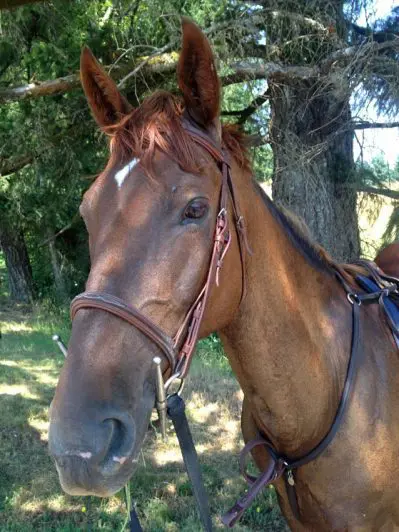
My faithful steed, Steve
The Siuslaw National Forest offers the most challenging riding of the week, and also some of the best views, whether from the depth of verdant vegetation or the expansive sights from the mountains’ summits. In the cool and shady forest there’s a chance to glimpse the Silver Spotted Butterfly, a protected species in the area. There is also variety in landscapes, with one day’s trail passing through an area being actively logged, which provides some contrast and some more open views of the landscape.
- Enjoying the view from atop the Coast Range
- Proposal Rock, on the beach right outside the accommodations
After reaching the coast your beach ride will be on a quiet morning when the tide is still out. The coast is amazingly cool and damp, even when the interior temperatures are blazing. After a few hours riding in the sand with some canters near the surf you will dismount for another picnic lunch. Lunches each day are provided along the route, with fixings for sandwiches on delicious varieties of bread, with local fruits and vegetables. The evening meals are at local restaurants and breakfasts are provided at the Bed & Breakfasts or condo you stay in.
You sample three different accommodations throughout the course of the trip, a family run B&B and farm in the forest for the first night, a beach condo right on the beach for the next three nights, and then a B&B in the town of Carlton for the last two nights. All of these places are comfortable and cozy and the food is gourmet and plentiful, with many tasty local ingredients such as Tillamook dairy and, of course, Oregon wine.
After staying at and riding on the beach the trip returns to the horses’ and hosts’ home of Carlton. This is the heart of wine country, with tasting rooms available all along the charming downtown main street. The final day of horseback riding in Oregon takes place on the grounds of a beautiful vineyard with a spectacular view of the Willamette Valley.
This was the only day we had to be aware of hot temperatures and had an early start to enjoy a few hours of exploring the vineyard before retiring to the tasting room for a catered lunch and wine tasting.
- Preparations for tasting the famous Oregon wines
- Breakfast Menu at the Carlton B&B
That evening we had time to wander the downtown of nearby McMinnville, another small town boasting a strong local culture of artisans and gourmets before enjoying a final meal all together. While the trip’s focus is satisfying riding for avid equestrians, the beach and winery visits make it a pleasure for the rider’s other sensibilities as well. The Willamette Coast ride offers diversity of riding on excellent horses in a unique and interesting location with wonderful hosts, all close to home!
Ride Review by Megan Barrett
Castles, Caves, Vineyards, Forests, Medieval Villages and Foie Gras
Since we started Equitours some 35 years ago I have had the wonderful good fortune to do over a hundred rides around the world. My latest ride, the Castles and Caves of Malbec, was a delight, especially since it was my 85th birthday ride. If you enjoy good horses, good food, great wine, lovely countryside rich in history and friendly companions this would be hard to beat. There were eight of us on the trip, mostly old friends and one splendid new addition; Teri, the international vet who takes care of everything from tigers to elephants. Actually it seems to me that for someone who likes this sort of thing I have about the best job imaginable. One of our riders asked me at lunch how I had been clever enough to manage to have a life style like this and I was considering a suitable answer when Teri, the irrepressible vet, popped up with, “Pure, dumb luck!” which set everyone laughing uproariously and has to be fairly close to the truth.
Another plus on this trip was that Michel’s organization was impeccable; things happened on time, the accommodations and picnic places were well chosen. The van always awaited us with food and drink when we arrived. The lodgings were in charming, picturesque inns or B & Bs. The well trained horses never put a foot wrong and were always saddled and ready for us to mount. The pacing of the ride was good though the back country roads and trails we took were often too rocky for speed, but every day we had chances for several fast canters where the terrain was suitable.
The first two days we rode through the rolling hills of vineyard country in the Bergerac area and grape vines stretched in every direction as far as you could see. They seemed to be growing little else in the area which has been famous for its wine for thousands of years. We made stops at several old castles where the grapes were turned into wine and the cellars contained hundreds of huge oaken barrels full of aging liquid. They lined up rows of glasses with wine in various stages and with a variety of different grape blends and described the intricate process. Most of us were unable to absorb all the finer points of production, but one thing did become clear to all of us: there is a lot to know about producing a good wine for sale on a very competitive market. I wonder if modern technology has really improved the wine that much over what they produced a few centuries ago using more primitive techniques like peasant girls in bare feet trampling out the vintage.
As we continued on our hundred mile journey the landscape began to change and instead of vineyards we were winding on narrow trails through oak forests where the hills were steeper and there was no human habitation for miles. Now we were in truffle country where sniffer dogs are used to find these precious fungi (fetching $100 an ounce or so) deep below the surface. I fear my palate is not refined enough to fully appreciate truffles (especially at that price), but this is also famous paté de foie gras country and I did very much appreciate that along with many other delicious local dishes like the maigret de canard.
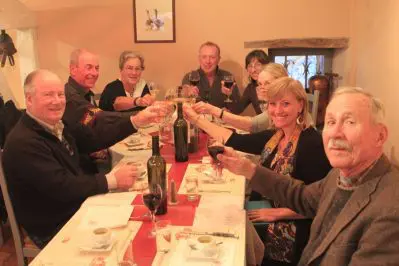
Our group at the dinner table tasting more of the region’s delicious specialties and drinking some Malbec wine.
We stopped for picnic lunches every day around noon and Béatrice would unfailingly meet us with the van. She would have the table prepared with bread baked that morning, many kinds of cold cuts, lovely cheese and mouth-watering pastries for dessert. We picnicked in small villages or beside rivers and took a short rest before heading on to discover new places. In the evening of our fourth day of riding we came upon the village of Saint-Cirq-Lapopie built on the side of a steep hillside above the Lot River. Our first view of the place was breathtaking. I have seen many lovely towns and villages in my day, but this town is on the top of my list for its picturesque, fairy-tale beauty and indeed it has been voted by the French as their favorite town. I can certainly see why.
We spent two nights here and I was sorry to leave. We stayed in a lovely inn and ate fabulous dinners. After the first night we departed early in the morning for the Chateau de Cénevières where we had lunch and then made a loop to return to Saint-Cirq-Lapopie by another route.
We were able to ride into the courtyard of this exquisitely maintained, 11th century castle as did the knights of old and we were given a fascinating tour of the castle by its owner who had restored many of the rooms so that visitors could see how people lived in ancient times. The tour also turned out to be a history course because the castle was the center of frequent wars like the Hundred Years War and religious wars which caused bloody upheavals to sweep the area again and again, making the castle’s high walls a matter of survival.
The last day of this ride in France gave us some nice canters along the Lot River and then the trail narrowed and took us through what amounted to a tunnel open on the river side. The ceiling was so low that we had to dismount and lead our horses for several hundred yards until we came to a bridge across the river which allowed us to cross and head up the other side. We traversed narrow trails through oak forests until we arrived at the caves of Pech-Merl somewhat like the more famous Lascaux. We had a guided tour of the huge cave with images of horses and other animals sketched on the walls dating back some 25,000 years. It made medieval villages seem almost modern as I reflected on the very ancient history of mankind in Europe.
After the caves we were off again through deserted forest trails with no sign of life until we suddenly came out of the woods to the edge of a seemingly almost sheer limestone escarpment at the bottom of which was the Célé river and the picture perfect village of Souillac with the red roofs of buildings set among the trees. The sides of the valley were so steep that at first glance it was hard to see how a horse could find its way down, but Michel knew a zigzagging trail which descended safely though at a sharp angle. It seemed to me that Souillac, though a tiny village, was just as picturesque as Saint-Cirq-Lapopie and it was a fitting destination for our last night with a superb dinner and many toasts all around. It was with great regret that I said goodbye to my companions and returned to Bergerac next day for my flight to London and home. I couldn’t feel very sad at leaving because I was returning to our beloved Wyoming ranch where spring had melted the snow, the grass was growing fast and wildflowers were beginning to bloom. Nevertheless I will long feel a certain feeling of nostalgia for this idyllic area.
Ride Review by Bayard Fox Photography: Claude Poulet
Escape to Paradise…
Ride Review by Aline Phillips
What better way to spend spring break than on a jungle ride in Belize with family? Leaving the long, bitter Wyoming winter behind, I happily embarked on the Mayan Jungle and Tikal Ride with my daughter (18) and son (23). A good friend, her 14-year-old daughter, and several other riders from the U.S. also joined our migration south to this warm weather destination.
One of the best things about this ride is the location: Belize is only a two hour flight from Houston, and in my opinion it’s the best kept riding vacation secret in the world, a dream-come-true for winter-weary horse enthusiasts.
Our guide, Rigo, was quick to teach us all about the vegetation along the trails. He wielded his machete at times to clear the path and, on other occasions, to cut chunks of a water vine so we could experience sipping sweet water from this plant. He pointed out the many colorful birds flitting around in the lush forest canopy of ferns, philodendron and palms. Many of the plants were in bloom; hibiscus, lady’s lips, orchids and bougainvillea, all lending a tantalizing aroma to the jungle air.
We swam in pools under waterfalls, reveling in the cool water. Vacation in paradise! Barton Creek Cave was our destination one day. We arrived in time for a picnic lunch at the edge of the stream. The cave is one of the longest caves in Belize and part of extensive subterranean riverine system. We climbed into canoes and paddled through the mouth of the cavern. When the spotlight was switched on it revealed a breathtaking array of stalactites, ledges and chambers. The Maya used this cave some 1800 years ago for worship and burial rituals.
The week was filled with great riding, memorable meals, diverse terrain and vegetation, fascinating caves, Mayan ruins, and the camaraderie of friends old and new. I think it’s an ideal getaway to enjoy a tropical paradise with family and friends.
An exceptional experience in every respect
Transfers
As expected, the representative of the ride safari was at the prescribed location next to the Johannesburg Airport information booth at the designated time holding a placard.
Departure was delayed due to late arrival of one flight, but this did not present a problem. The van was in excellent condition, clean and comfortable with water and ice placed in the vehicle for guests to use. A rest stop at a cafeteria was made at the halfway point. Customs formalities at the South Africa / Botswana border crossing at Pont Drift were efficient and proceeded without delay.
Riders
There were eight participants on the Tuli Safari during the week of October 6-13, 2013 as follows: five English women, a German couple and me. One of the participants from England had taken the same ride years earlier. All were experienced horse people so there were no problems with respect to ability. About half of the participants owned horses and two of the riders from England actively compete in horse shows. All participants were well matched with their assigned horses.
Reception
Upon arrival we were given a warm welcome by Louise Carlesen, Director, and other members of the staff. (We would meet Cor Carlesen later at a camp in the course of the ride). Afterwards we were treated to lunch and given a thorough briefing about the ride itinerary and safety procedures. We were also asked about our riding experience and preferences prior to the horses being assigned. Following the introduction we changed into our riding gear, mounted the horses and set off to the first permanent camp. Soon after our departure each rider was asked to individually demonstrate their riding skills at a walk, trot and canter over a short triangular course in the open. This ride should be suitable for all experienced and confident riders.
Guides
The ride was accompanied by the highly experienced guide, “West” Mmanoke, who led the group, and the assistant guide, Tsaone Radedibo, who brought up the rear. Both were highly skilled and knowledgeable and shared their experience about the region and wildlife throughout the week. They were very alert in spotting game and in keeping ample distance from elephants to avoid risks.
Horses
All horses in the ride were excellent. All were geldings of pure and mixed breed and included one Boerperd. Each horse was well-schooled, responsive and in excellent condition. During long canters in hot, dusty conditions no horse showed signs of tiring and there was no sweating, other than under the saddle pads. The horses went over jumps smoothly and without hesitation. They also got along well with each other.
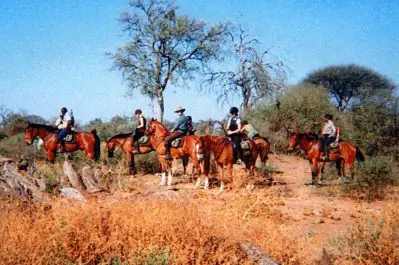
Our trusty steeds were Ajax, Big John, Calvero, Casablanca, Dennis, Foxy, General, Lancelot, Mister Fun, and Monate.
Grooms
Four grooms (one also served as a driver) took excellent care of the horses and the tack. The horses were properly fed with good quality hay and feed, given plenty of water and thoroughly checked in the morning and evening.
Tack
The tack was in excellent condition and was well maintained throughout the ride. I chose English tack and was very comfortable after many hours in the saddle. Saddlebags were provided and two bottles of water were placed in them at the beginning of each ride. The grooms were responsible for tacking and untacking the horses each day.
Itinerary
The ride was well planned and executed. This was to be expected in light of the fact that the Tuli Safari is conducted weekly from March through October.
The ride from camp to camp was thoroughly enjoyable given the variety of terrain, the spontaneity of game sightings and the wide range of wildlife species encountered. The outgoing personality and knowledge of the guide and his assistant were a big plus, as was the camaraderie among participants. Long riding times gave us the opportunity to “take it all in” and to appreciate the open space and exotic nature of this adventure. The route each day was particularly rewarding: galloping across open plains, crossing riverbeds, admiring the terrain, vegetation and wildlife, etc.

View from the safari vehicle. Our guides always kept us at safe distances from wildlife when on horseback.
Evening game drives by safari vehicle were also a highlight, giving participants the ability to see a variety of animals, including cheetah, elephants and lions up close in comparison to the distance maintained while on horseback.
Sunsets spent with drinks/ Sundowners in hand atop rock outcroppings with spectacular views of the riverbeds and the vast plains below provided a heavenly end to each day as the sun slipped below the horizon.
Pace
The ride was well paced and varied between walking and cantering, nearly always in single file. There was very little trotting. Canters included some enjoyable long stretches in open areas. Frequent stops were made when encountering wildlife as well as gallops near other animals including zebra and giraffes, generally at a distance of about 75 yards. The guides were particularly sensitive about maintaining a safe distance from elephants.

Thanks to our ever cautious and professional guides, there were no animal charges or incidents throughout the week.
Each day there was generally a rest break of about half an hour in the morning and afternoon in the shade of huge Mashatu trees. During these stops, participants were given light snacks, including apples and cakes. There were numerous crossings of dry riverbeds, some of which had moderately steep inclines. A number of stops were made at waterholes and streams for the horses. On several occasions riders had the opportunity to jump over downed trees and natural obstacles.
Climate
The ride took place in the spring. The climate was dry as were nearly all riverbeds. There was no rain throughout the week. The temperature during the day was hot and, in my estimation, approached 100 degrees by midday. Rides departed around 7AM each day. There was also plenty of dust kicked up by the horses, especially during canters, as we were riding in single file. Evening and overnight temperatures were pleasant.

In our outdoor camp we gazed in awe upon the majesty of the Southern Constellation before drifting off to sleep.
Accommodations
All camps were located in attractive areas. Tents were spacious and equipped with water, bowls, soaps and towels for shaving and freshening up. Each tent had its own flush toilet or drop latrine. Two nights at the Kgotia Camp featured sleeping outdoors, which was very enjoyable. Adequate shower facilities were present at all locations. Luggage was transferred from camp to camp during the ride and placed in the respective tents prior to arrival of the riders in the afternoon.
Meals
All meals were excellently prepared and included a variety of drinks, salads, meats, vegetables and desserts. The quality and variety of food were excellent and better than expected. This was particularly noteworthy in light of the logistics of moving from camp to camp each day. Hot coffee, tea or hot chocolate was delivered to each tent at the time of the morning “wake up” call. Early breakfasts included fruits, cereal and breads, together with coffee, tea and juices. The varied menu for lunch and dinner were particularly noteworthy. Plenty of food and a variety of drinks ( water / soda / wine / beer / coffee / tea ) were available.
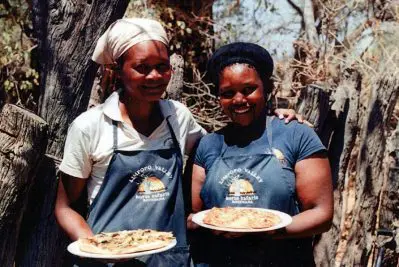
It was clear that the cook, Grace Mosholombe, and her assistant, Queen Bale, took pride in their work. Sanitation standards were high.
Summary
The Tuli Safari is an incredible adventure enabling equestrian enthusiasts to thoroughly appreciate spectacular landscape and a profusion of wildlife that is unique to the Tuli District of Botswana. Experiencing this majesty in a small group aboard willing horses under the guidance of personable and knowledgeable guides is unrivaled. The magic continues after dismount with evening game drives, spectacular sunsets savored from high vantage points, animated conversation over excellently prepared meals beside the fire and culminating with the awe of gazing upon the majesty of the Southern Constellation before drifting off to sleep. This is a lifetime experience not to be missed.
Ride Review by Robert Savarese
Mountain Riding in Spain
Riding High In the Sierra Nevadas Sitting now in my living room in Verona, Wisconsin, it is hard to believe that a week ago I was sleeping in a rustic inn in Trevelez, the highest village in Spain, following... Browse article
On Castles, Caves and the French Malbec Trail
To the drum of my horse’s hooves In this travel exposé I am supposed to write of the itinerary of the french Malbec Trail…to describe the incredible, ancient french villas we slept in, to expound upon the minerality and... Browse article
A History of Horseback Riding in Wyoming
How Horseback Riding shaped Wyoming’s History Though horses originated in America, there was a 10,000 year hiatus in the history of horses on this continent because it seems that about that long ago Native Americans hunted them to extinction,... Browse article
Kalahari Bush Ride
Dr. Livingstone, I presume? Tree Lodge was the perfect location to recover from the long haul flight New York to Johannesburg and on to Maun. The charming raised tented cabins surrounded by the bush made us feel at home... Browse article
Journal of George Richardson in Tanzania, January 2014
A Tough Act to Follow Below, George Richardson shares the journal of his experience on the Lake Natron Safari. Please also see his reactions to his second Tanzanian trip in 2016. Day 1:”Assembly” Departed Amsterdam for the KLM flight to KIA... Browse article
History of Horseback Riding in France
As the superb cave paintings at Lascaux and elsewhere attest, horses have existed in Western Europe for over 30 millennia and must have provided an important source of food for local hunters. We do not know just when people... Browse article
History of Horseback Riding in Spain; The Spanish Horse
History of Horseback Riding in Spain; From Alta Mira to the American Plains The arrival date for the first wild horses to reach Spain after their ancestors crossed the Bering Straits from America is lost to us in the... Browse article
Africa Ride: Lake Natron and the Serengeti
Africa at its Best Careful not to overtake our leader, we cantered through the long grass towards camp, marked by a line of tents, nestled under spreading acacia trees.The shadows lengthened behind Ol Doinyo Lengai, “Mountain of God” to... Browse article
Advantages of Solo Travel on Horseback
Making New Equestrian Friends If you love to ride, but the rest of your family and friends don’t share your enthusiasm, join one of our horseback riding vacations where you have a good chance of making new friends with... Browse article
Family ride: Destination Donegal
Of Kids and Connemaras There were four children in our group of eight, including my 11-year-old son and 10-year-old daughter. I’d been toying with the idea that there must be a fair number of parents, grandparents, aunts and uncles... Browse article
A Verdant Welsh Mountain Ride
So Green were the Valleys Please note we do not currently have a ride in Wales, but have other options in Northern Europe and are working on expanding our repertoire in the area! After riding numerous times over the... Browse article
A “must read” memoir for horse lovers written by our Mozambique outfitter.
One Hundred and Four Horses Equitours works with fascinating and inspiring riding tour outfitters all over the world but the story of Mandy and Pat Retzlaff, our Mozambique operators, is one of the most heart-touching, uplifting, and certainly unique.... Browse article



